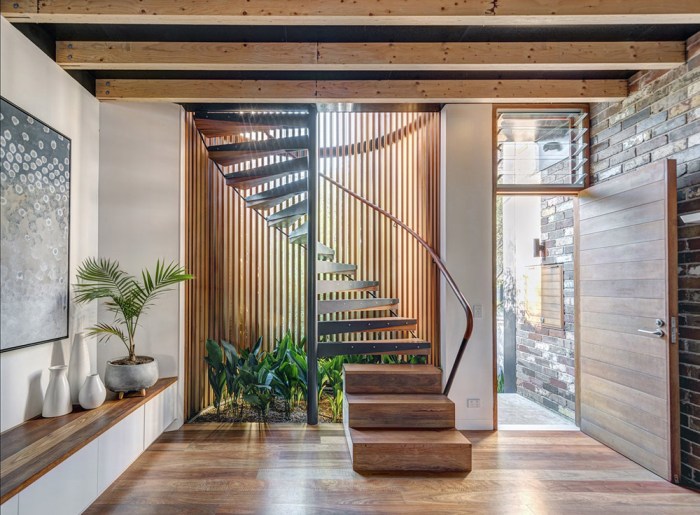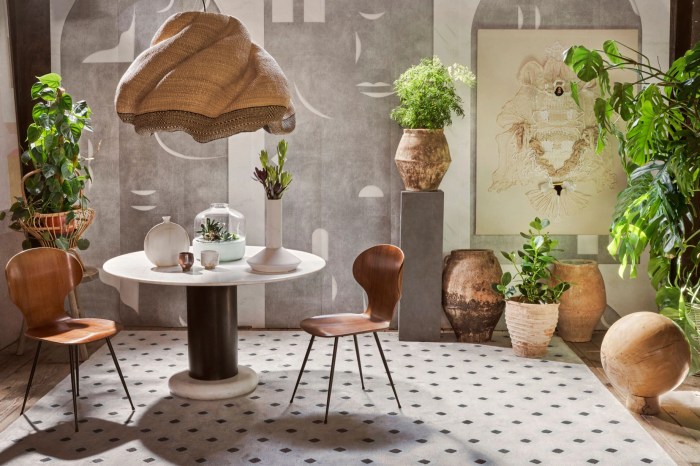Crafting Sustainable Interior Design: A Pathway to Eco-Friendly Living
Embark on a journey through the realm of sustainable interior design, where creativity meets environmental consciousness. Discover how this innovative approach not only enhances the aesthetic appeal of spaces but also contributes to a greener, more sustainable future.
Delve deeper into the realm of sustainable practices, materials, and design principles that are revolutionizing the way we approach interior design.
Overview of Sustainable Interior Design
Sustainable interior design focuses on creating spaces that are environmentally friendly, energy-efficient, and socially responsible. It aims to minimize the negative impact on the environment while enhancing the health and well-being of occupants.
Principles of Sustainable Interior Design
- Use of eco-friendly materials such as reclaimed wood, bamboo, cork, and recycled glass
- Energy-efficient lighting and appliances to reduce energy consumption
- Water-saving fixtures and fittings to promote water conservation
- Indoor air quality improvement through proper ventilation and the use of non-toxic paints and finishes
Examples of Sustainable Materials
Sustainable interior design often incorporates materials that are renewable, recycled, or repurposed. Some common examples include:
- Bamboo flooring: A fast-growing, renewable resource that is durable and eco-friendly
- Recycled glass countertops: Made from recycled glass bottles and jars, reducing waste and energy consumption
- Cork wall tiles: Harvested from the bark of cork oak trees without harming the tree, providing a sustainable and sound-absorbing material
Benefits of Sustainable Practices
Incorporating sustainable practices in interior design projects offers various benefits, such as:
- Reduced environmental impact by using eco-friendly materials and energy-efficient systems
- Improved indoor air quality, promoting health and well-being for occupants
- Cost savings through lower energy and water consumption in the long run
- Supporting the local economy by sourcing materials from nearby suppliers
Sustainable Materials and Finishes
When it comes to sustainable interior design, choosing the right materials and finishes is crucial. Not only do they impact the environment, but they also affect the aesthetics and durability of the space.
Eco-Friendly Materials for Sustainable Interior Design
- Bamboo: A fast-growing, renewable resource that is durable and versatile.
- Recycled glass: Can be used for countertops, tiles, and decorative accents, reducing waste and energy consumption.
- Cork: Harvested from the bark of cork oak trees without harming them, cork is a sustainable and sound-absorbing material.
- Reclaimed wood: Salvaged from old buildings or furniture, giving a unique look while reducing the demand for new timber.
Environmental Impact of Traditional Materials vs. Sustainable Alternatives
Traditional materials like concrete, plastic, and non-renewable hardwoods often require high energy consumption and contribute to deforestation and pollution. In contrast, sustainable alternatives use renewable resources, reduce waste, and have lower carbon footprints.
Sourcing Sustainable Materials for Interior Design Projects
- Look for certifications like FSC (Forest Stewardship Council) for wood products to ensure they come from responsibly managed forests.
- Choose local suppliers to reduce transportation emissions and support the local economy.
- Consider upcycling or repurposing materials to give them a new life in your design projects.
Aesthetic Appeal and Durability of Sustainable Finishes
Sustainable finishes can be just as stylish and durable as traditional options. For example, natural clay plasters offer a unique texture and color palette, while recycled metal tiles can add a modern touch to any space. These finishes are not only eco-friendly but also long-lasting and low-maintenance.
Energy Efficiency and Lighting

When it comes to sustainable interior design, energy efficiency plays a crucial role in reducing environmental impact and operating costs. One key aspect of energy efficiency is proper lighting design, which not only enhances the aesthetics of a space but also contributes to its overall sustainability
Improving Energy Efficiency
Optimizing energy efficiency in interior spaces can be achieved through various strategies, such as:
- Utilizing natural light whenever possible to reduce the need for artificial lighting.
- Installing energy-efficient lighting fixtures, such as LED bulbs or CFLs, that consume less electricity.
- Using dimmer switches or sensors to control lighting levels based on occupancy and natural light availability.
- Implementing smart home technology to automate lighting schedules and reduce energy waste.
Role of Natural Lighting
Natural lighting not only helps in reducing energy consumption but also enhances the well-being of occupants by providing a connection to the outdoors. It is essential to maximize the use of natural light through proper window placement, skylights, and light shelves to create a more sustainable and comfortable interior environment.
Selecting Energy-Efficient Lighting Fixtures
When choosing lighting fixtures for a sustainable interior design project, consider the following tips:
- Look for fixtures with the ENERGY STAR label to ensure high energy efficiency standards.
- Opt for adjustable fixtures that allow you to direct light where it is needed, reducing wastage.
- Choose LED or CFL bulbs over incandescent ones for longer lifespan and lower energy consumption.
- Consider the color temperature of the lighting to create the desired ambiance while saving energy.
Impact of Lighting Design
The design of lighting systems can significantly impact the sustainability of a space. By incorporating energy-efficient fixtures, maximizing natural light, and implementing lighting controls, interior designers can reduce energy consumption, lower carbon emissions, and create healthier indoor environments for occupants.
Indoor Air Quality and Eco-Friendly Practices
Indoor air quality plays a crucial role in creating a healthy and sustainable interior environment. By implementing eco-friendly practices, we can enhance the air quality within our living spaces, ensuring the well-being of occupants and reducing the impact on the environment.
Enhancing Indoor Air Quality Through Design Choices
Design choices such as selecting non-toxic paints, finishes, and furnishings can significantly improve indoor air quality. Opting for natural materials like wood, bamboo, and cork can also help reduce the presence of harmful chemicals in the air.
Importance of Ventilation Systems
Ventilation systems are essential in sustainable interior design as they help circulate fresh air and remove indoor pollutants. Proper ventilation not only improves air quality but also enhances the overall comfort and well-being of occupants.
Tips for Reducing Indoor Pollutants
- Use air purifying plants such as peace lilies, spider plants, and aloe vera to naturally filter out toxins from the air.
- Choose low-VOC (volatile organic compound) paints and finishes to minimize harmful emissions.
- Regularly clean and dust interior spaces to prevent the buildup of allergens and pollutants.
- Avoid synthetic fragrances and opt for natural alternatives to reduce indoor air pollution.
Benefits of Incorporating Plants for Air Purification
Plants not only add aesthetic value to interior spaces but also serve as natural air purifiers. They can help remove toxins such as formaldehyde, benzene, and trichloroethylene from the air, creating a healthier and more sustainable indoor environment.
Final Summary

As we conclude our exploration of sustainable interior design, we reflect on the transformative power of eco-friendly choices in shaping the spaces we inhabit. Embrace sustainability as a guiding principle in design, and pave the way for a harmonious coexistence with our environment.
Detailed FAQs
What are the key principles of sustainable interior design?
Sustainable interior design focuses on minimizing environmental impact, maximizing energy efficiency, and using eco-friendly materials.
How can I source sustainable materials for my interior design projects?
You can find sustainable materials through eco-conscious suppliers, reclaimed material sources, and certified sustainable product databases.
Why is indoor air quality important in sustainable interior design?
Indoor air quality directly impacts health and well-being, making it crucial to prioritize in sustainable design for a healthier living environment.